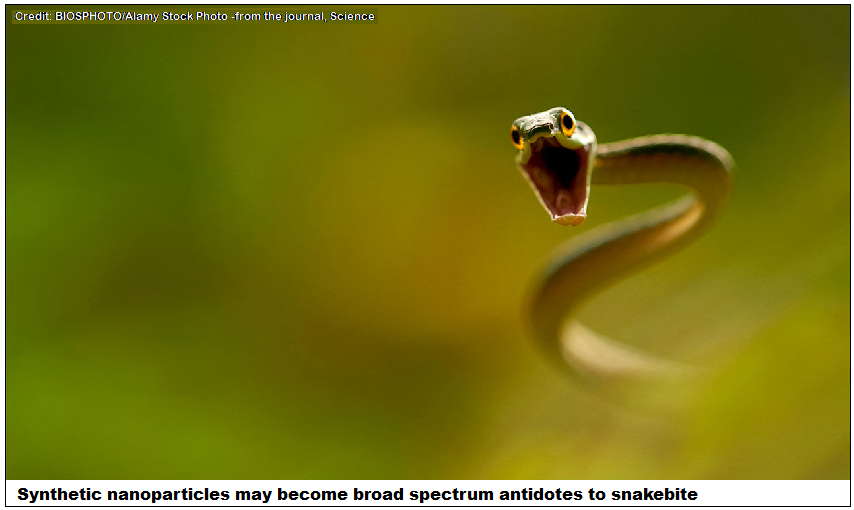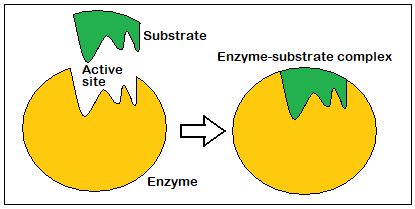Custom-made polymers may help win the war against snakebite, says S.Ananthanarayanan.
Dealing with snakebite presents a twin challenge – first to identify the correct antidote, and then, to get it to where it is needed without delay.

Masahiko Nakamoto, Di Zhao, Olivia Rose Benice, Shih-Hui Lee, and Kenneth J. Shea, from the University of California, Irvine, Irvine, California, describe in the Journal of the American Chemical Society (JACS), their work of creating a synthetic mimic of the biological constituents of antivenin and packing it in the form of a nanoparticle. A device like this could be transported, stored and administered more easily than existing ways of dealing with snakebite. It could also be made effective against many toxins and could be mass-produced.
the organism that is bitten, through the fangs, which are sharp go deep into tissue. The venom consists of proteins and enzymes, or substances that act by speeding up or slowing down body processes. Some of them lead to tissue damage, by destroying body cells, and limbs or organs. Others act by affecting the nervous system. Nerves communicate by passing chemical signals, which cause windows in the cell wall to open and allow electrically charged ions to move. Snake venom either blocks the sites where nerve cells transmit or receive chemical signals or it interferes with the opening of the cell wall. The result is muscle paralysis, which prevents prey from escaping, and respiratory failure, and death. A third way snake venom acts is by affecting the blood. Blood corpuscles are made to burst. The process of clotting is disrupted, and this leads to internal bleeding. Some poisons make blood cells clump together, in clots that block blood vessels.
The method of choice, the only active method, in fact, to deal with snakebite, is to administer antivenin, which consists of the antibodies that animals generate to neutralize snake venom. The method, which was developed in the 1800s, is somewhat like vaccination against rabies or smallpox. A mild dose of a particular snake venom is injected into an animal, such as a horse, and the animal’s blood is harvested after a few days. Antibodies in the blood are separated, and used to help human snakebite victim combat the venom.
The method has several disadvantages. For one, producing antivenin is time-consuming. Next, as living, poisonous snakes need to be captured and brought to the laboratory for venom extraction, it is expensive. As antivenin is produce in the body of an animal, it results in reactions when injected into humans. Administration also needs trained medical personnel. And, then, antivenin is usually specific to particular species of snakes. And finally, antivenin needs some extent of refrigeration, which is not available in many places where there is the greatest need for antivenin.
Recent work has identified thousands of genes associated with the venom glands of Naja naja, the Indian cobra, narrowed down to 139 toxin genes and 19 specific toxins, which probably encode the core proteins involved in cobra venom. The advance presents the possibility of producing synthetic venom, for easier production of antivenin and antivenin effective against venom of more species of snakes.
The scourge of snakebite, however, presents a demanding challenge and is urgent. Worldwide, there are some 5 million snakebites every year, leading to 400,000 amputations of limbs and over 100,000 deaths. In India, where poisonous snakes include the cobra, Russel’s viper, the saw-scaled viper and the common krait, there are over 46,000 deaths from snakebite every year. And India, other parts of south East Asia and Africa are the worst effected, with several poisonous snake species, persons who work barefoot in the countryside and in fields, and scant medical presence. The work of the team in the University of California at Irvine may lead to an effective answer.
The paper in JACS notes that the snake venom antibodies and antivenin act by a common biological process, of inhibiting the action of the enzymes that make up snake venom. Enzymes, including snake venoms, act because they have ‘active sites’, which are ‘lock and key’ fits to specific ‘substrates’, which either provide stepping stones for other chemical reactions to take place or to prevent chemical reactions. A way to inhibit the action of an enzyme is with a molecule that interacts with the active sites of the enzyme, or near the active sites, to block access to the sites. While molecules, complex, but comparatively smaller than proteins, are commonly used in pharmacology to regulate biological processes, the paper notes that elongated chains of molecules or very small particles can interact at different locations in the structure of enzymes, to block them more effectively. An advantage with chain molecules, which offer large reactive and can regulate enzyme behavior, is that their own structure, and hence action, is under the experimenters’ control.

The Irvine team hence worked towards creating a synthetic chain molecule nanoparticle that could act against a group of enzymes that are responsible for most of the toxic action of the venom of a number of species of snakes. These enzymes are collectively called snake venom metalloproteinase (SVMP), or ‘metal containing enzymes that break proteins into components’. The team took inspiration from naturally occurring substances that inhibit the action of these enzymes. X-Ray studies of how this happens showed that the inhibitor worked by binding to the part of the enzyme that has a charged zinc atom, the active site, and then, more points of contact. The team hence fashioned their mimic chain molecule particle to have these three attributes.
The paper refers to recent work of the same university, where synthetic chain molecules nanoparticles have been ‘engineered’ for efficacy against the common portion of a number of snake venom components. In order to attain a broad-spectrum antidote to venom, the team surveyed the SVMP family and the small molecule inhibiters that have been developed. Using data of this kind, the team identified what features their target chain molecule nanoparticle would need to have
Combinations of the nanoparticles with the necessary features were then tried out to determine the optimum mixture, and then tested. Trials with the puff adder, the Gaboon viper, West African carpet viper, saw-scaled viper and diamond-backed rattlesnake showed that a given combination did have broad-spectrum effectiveness. “Our results demonstrate the potential of NPs to be engineered to function as an abiotic antidote of snake envenoming,” the authors say.
Broad-spectrum antivenin in the form of synthetic nanoparticles would be a game-changer in dealing with snakebite. A main requirement when there is a snakebite is prompt treatment. If the patient needs to be taken from health unit to health unit in search for antivenin, tissue damage, usually at the site of the bite, may result in need for amputation, even if the patient’s life is saved. Antivenin in the form of easily manufactured and easily handled nanoparticles would make it possible, and affordable, to have stocks at remote places.
------------------------------------------------------------------------------------------ Do respond to : response@simplescience.in-------------------------------------------